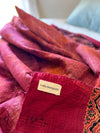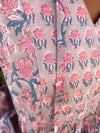
Indian ikat, one of the oldest and most enigmatic textile crafts, is a marvel of craftsmanship that defies imagination with its intricate execution and beautiful results. This fabric, where the patterns seem to float and blend as if hand-painted, is nevertheless woven with a precision that borders on genius.
Indeed, Ikat is distinguished by a technique as ancient as it is mysterious, where cotton or silk threads are dyed before they are even woven! Ikat uses a resist dyeing method, in which the patterns are drawn not on the surface of the fabric, but in the very structure of the threads: these threads are carefully knotted in precise places, protected from the dye by ties, and then dipped in baths of color. This process is repeated several times, each shade and pattern meticulously planned before the threads are finally woven together to reveal the hidden design.
What makes Ikat such a unique and fascinating art is the precision required for the patterns to take shape during weaving. Each dyed thread must be placed exactly where it was intended for the design to appear clearly. This perfect symmetry, which seems almost impossible to achieve by hand, requires absolute mastery of the technique. Each pattern, whether geometric, floral, or abstract, is a testament to the skill and vision of the artisan.
Ikat is an art that plays with perception. Its slightly blurred patterns, as if seen through a dreamlike veil, give the fabric a vibrant, lifelike quality, full of movement—a visual effect that only the skilled hands of artisans can create. The pattern appears both anchored in the fabric and free to float, offering a depth and poetic dimension that few other textiles can match.
From Gujarat to Odisha, Telangana to Andhra Pradesh, each region of India has developed its own style of Ikat, each with its own unique characteristics. For example, the Patola Ikat of Gujarat is famous for its intricate patterns and double Ikat technique, where both the warp and weft threads are dyed before weaving, creating designs of unparalleled precision and visual richness.
Ikat is also closely linked to spirituality and rituals. In some Indian cultures, ikat fabrics were worn during religious ceremonies, symbolizing the connection between the tangible and intangible, the visible and the invisible. The patterns themselves are often imbued with symbolism, representing natural elements such as clouds, rivers, or mountains, or sacred motifs such as mythological animals and divine figures.
Today, Ikat is experiencing a global revival, attracting fashion designers and craft enthusiasts worldwide. This unique fabric, with its irregular yet expertly orchestrated patterns, embodies a return to authenticity in a world of mass production. Choosing an Ikat fabric means choosing the art of slowness and patience, and honoring the work of those who, for weeks, sometimes months, transform a simple thread into a woven work of art.




0 comments